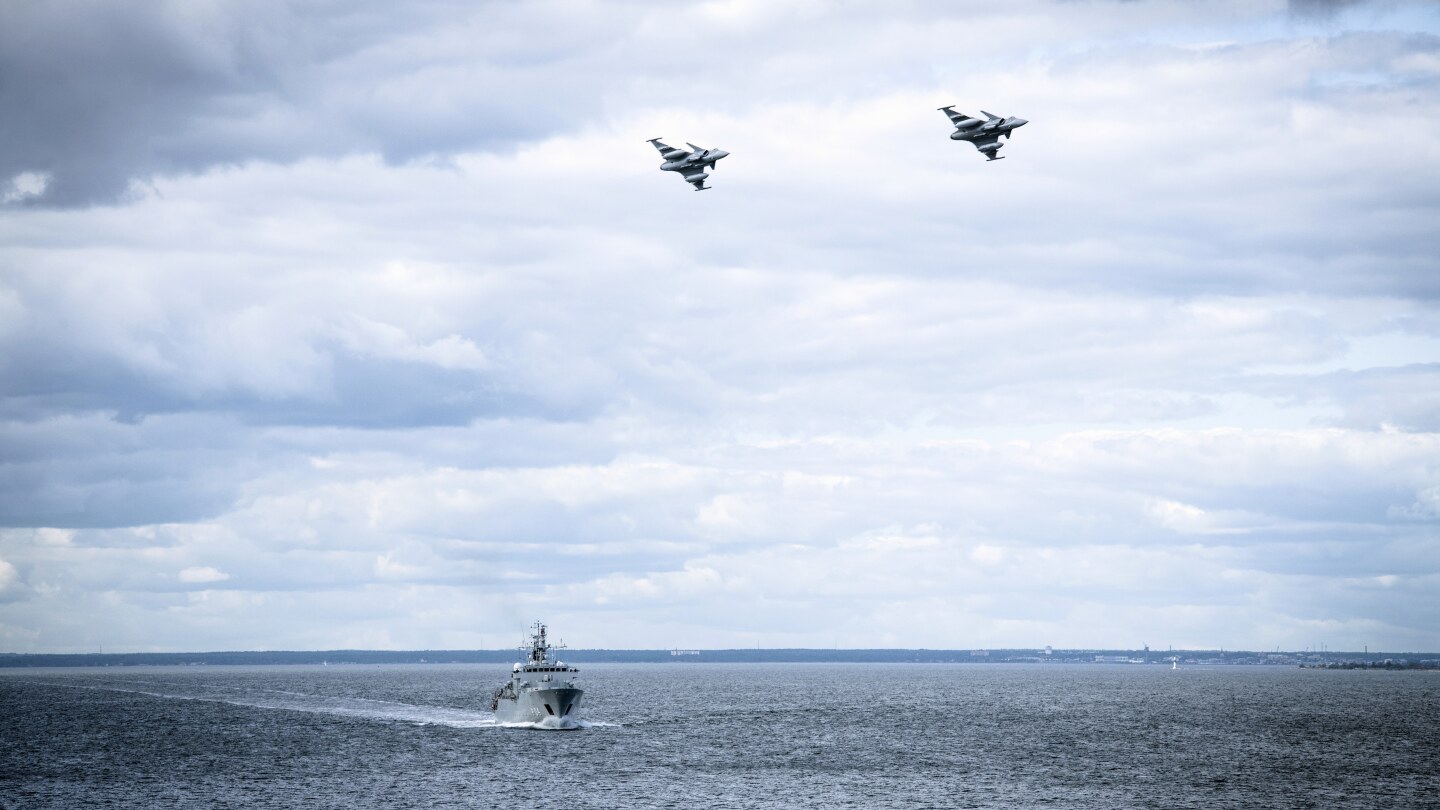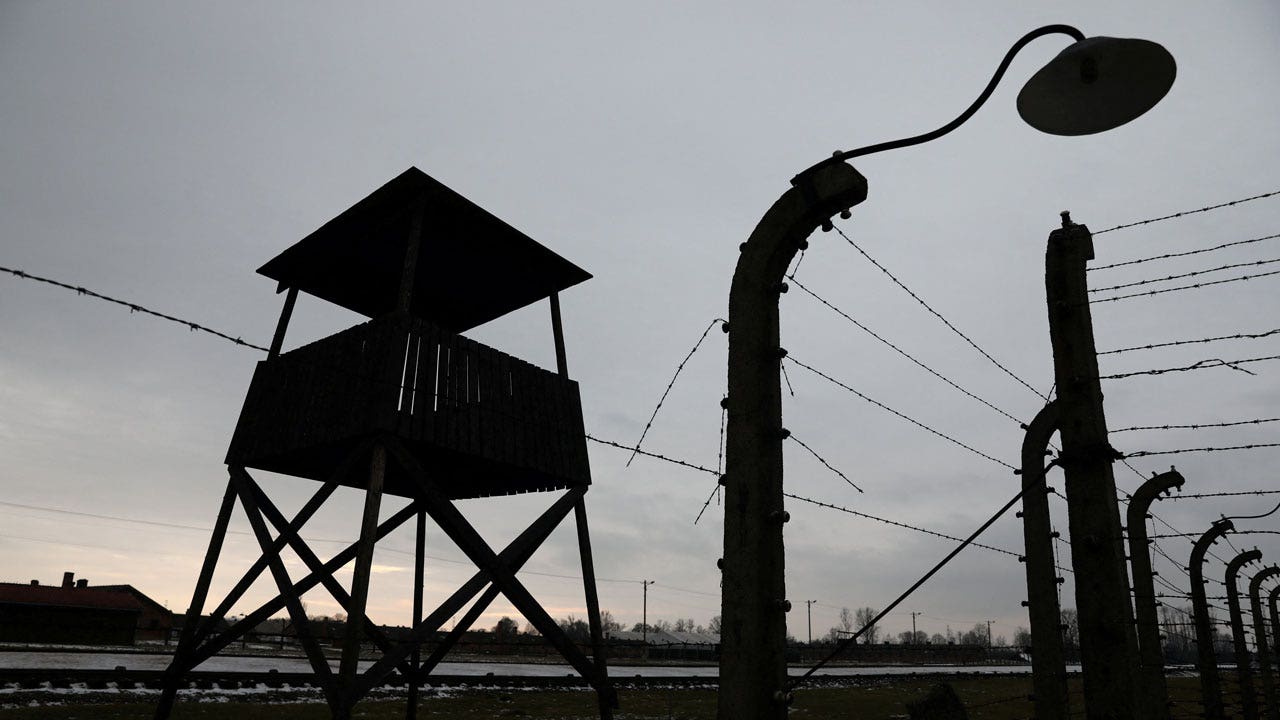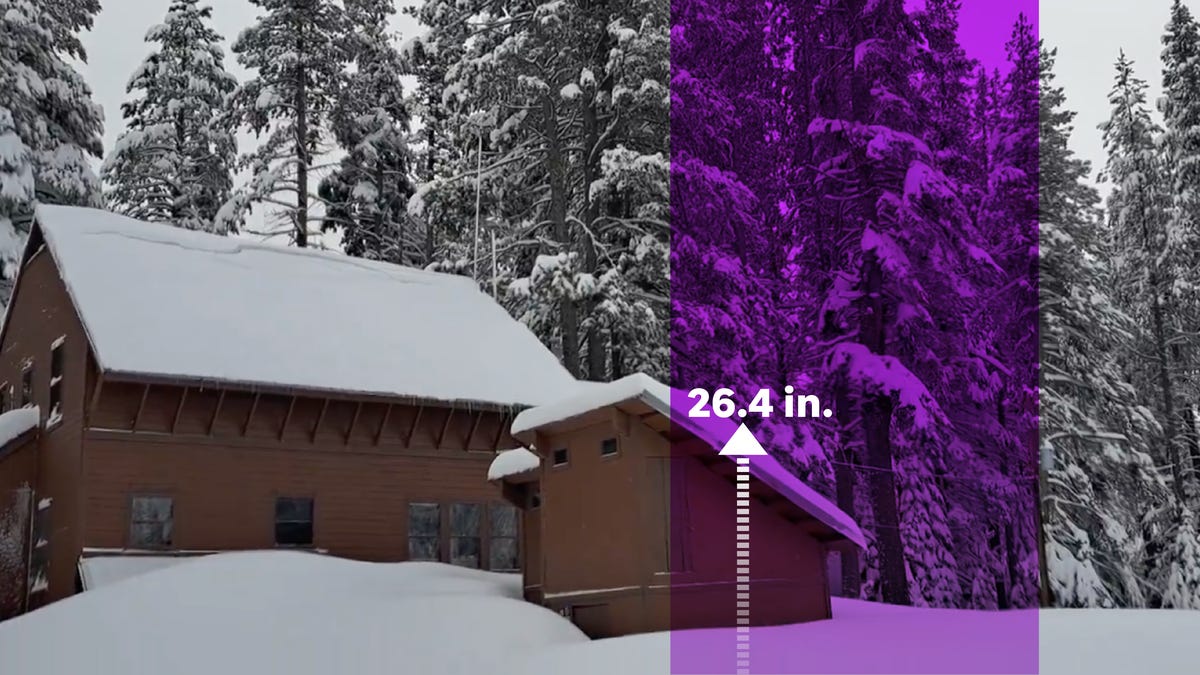World
Here's what to know about Sweden's bumpy road toward NATO membership

STOCKHOLM (AP) — Sweden’s bid to join NATO — held up for almost two years — cleared its next-to-last hurdle when Turkey’s parliament gave its go-ahead to let the Nordic country into the alliance.
All existing NATO countries must give their approval before a new member can join the alliance, and Hungary is now the only member that hasn’t given Sweden the green light.
Here is a look at Sweden’s complicated path toward NATO membership.
WHY DOES SWEDEN WANT TO JOIN NATO?
Sweden has stayed out of military alliances for more than 200 years and long ruled out seeking NATO membership. But after Russia’s full-scale invasion of Ukraine in February 2022, it ditched its longstanding policy of nonalignment almost overnight and decided to apply to join the alliance together with neighboring Finland.
Both Sweden and Finland had already developed strong ties with NATO after the end of the Cold War, but public opinion remained firmly against full membership until the war in Ukraine.
Nonalignment was seen as the best way to avoid creating tensions with Russia, their powerful neighbor in the Baltic Sea region. But the Russian aggression caused a dramatic shift in both countries, with polls showing a surge in support for NATO membership.
Political parties in both Finland and Sweden decided they needed the security guarantees that only come with full membership in the U.S.-led alliance.
WHY IS IT TAKING SO LONG?
While Finland became NATO’s 31st member in April of last year, Sweden’s application has been held up by Turkey and Hungary.
To let Sweden join, Turkish President Recep Tayyip Erdogan put forth a series of conditions including a tougher stance toward groups that Turkey regards as threats to its security, such as Kurdish militants and members of a network it blames for a failed coup in 2016.
Although the Swedish government tried to appease Erdogan by lifting an arms embargo on Turkey and promising to cooperate on fighting terrorism, public demonstrations in Sweden by supporters of the outlawed Kurdistan Workers’ Party, or PKK, and by anti-Muslim activists who burned the Quran complicated the situation.
Pressure from the U.S. and other NATO allies on Turkey to remove its objections to Swedish membership appeared to have little effect until Erdogan said at a NATO summit last year that he would send the documents to Parliament for approval. But the issue was held up in Parliament until lawmakers finally held a vote on the issue Tuesday and ratified Sweden’s accession protocol by 287 votes to 55.
That leaves Hungary as the last hurdle for Sweden’s NATO bid. Hungary initially didn’t given any clear reason for its delays and Prime Minister Viktor Orbán long insisted that his country wouldn’t be the last to give Sweden its approval. But the tone toward Stockholm hardened last year, with Hungary accusing Swedish politicians of telling “blatant lies” about the condition of Hungary’s democracy.
Orbán, who has broken ranks with NATO allies by adopting a Kremlin-friendly stance toward Russia’s invasion of Ukraine, said Tuesday that he had invited Swedish Prime Minister Ulf Kristersson to Budapest to discuss “future cooperation in the field of security and defence as allies and partners.”
Unless an emergency session of Hungary’s parliament is called to debate Sweden’s NATO bid, its next scheduled assembly is expected on Feb. 26.
WHAT WOULD SWEDEN BRING TO THE ALLIANCE?
The inclusion of Sweden would leave the Baltic Sea surrounded by NATO countries, strengthening the alliance in the strategically important region. The Baltic Sea is Russia’s maritime point of access to the city of St. Petersburg and the Kaliningrad enclave.
Sweden’s armed forces, though sharply downsized since the Cold War, are widely seen as a potential boost to NATO’s collective defense in the region. The Swedes have a modern air force and navy and have committed to increase defense spending to reach NATO’s target of 2% of gross domestic product.
Like the Finns, Swedish forces have for years participated in joint exercises with NATO.
HOW HAS RUSSIA REACTED?
Not surprisingly, Moscow reacted negatively to Sweden and Finland’s decision to abandon nonalignment and seek NATO membership, and warned of unspecified countermeasures.
Russia said the move adversely affected the security situation in Northern Europe, which it said ”had previously been one of the most stable regions in the world.”
Finland’s security service said in October that the country’s relations with Russia had deteriorated significantly and that Moscow now considers its western neighbor as a hostile country.
Both Sweden and Finland have warned of an increased risk of Russian interference and hybrid attacks.

World
Text of the Gaza ceasefire proposal approved by Hamas

Al Jazeera has obtained a copy of the Gaza ceasefire proposal that Hamas said it accepted on Monday. The deal, which was put forward by Egypt and Qatar, would come in three stages that would see an initial halt in the fighting leading to lasting calm and the withdrawal of Israeli troops from the Palestinian territory.
The proposed agreement would also ensure the release of Israeli captives in Gaza as well as an unspecified number of Palestinians held in Israeli jails.
Israel has said that it does not agree to the proposal but that it will engage in further talks to secure an agreement – all while pushing on with its assault on Gaza.
Meanwhile, the United States, which is also involved in the negotiations, said it is reviewing the Hamas response.
Here’s the text of the proposed deal:
The basic principles for an agreement between the Israeli side and the Palestinian side in Gaza on the exchange of captives and prisoners between them and the return of sustainable calm.
The framework agreement aims at: The release of all Israeli captives in the Gaza Strip, civilians or military, alive or otherwise, from all periods, in exchange for a number of prisoners held by Israel as agreed upon, and a return to a sustainable calm that leads to a permanent ceasefire and a withdrawal of Israeli forces from the Gaza Strip, its reconstruction and the lifting of the siege.
The framework agreement consists of three related and interconnected stages, which are as follows:
The first stage (42 days)
[Herein] a temporary cessation of military operations between the two parties, and the withdrawal of Israeli forces eastward and away from densely populated areas to a defined area along the border all along the Gaza Strip (including Wadi Gaza, known as the Netzarim Corridor, and Kuwait Roundabout, as below).
All aviation (military and reconnaissance) in the Gaza Strip shall cease for 10 hours a day, and for 12 hours on the days when captives and prisoners are being exchanged.
Internally displaced people in Gaza shall return to their areas of residence and Israel shall withdraw from Wadi Gaza, the Netzarim corridor, and the Kuwait Roundabout:
- On the third day (after the release of three captives), Israeli forces are to withdraw completely from al-Rashid Street in the east to Salah al-Din Street, and dismantle military sites and installations in this area.
- Displaced persons (unarmed) shall return to their areas of residence and all residents of Gaza shall be allowed freedom of movement in all parts of the Strip.
- Humanitarian aid shall be allowed in via al-Rashid Street from the first day without any obstacles.
- On the 22nd day (after the release of half the living civilian captives in Gaza, including female soldiers), Israeli forces are to withdraw from the centre of the Gaza Strip (especially the Netzarim/Martyrs Corridor and the Kuwait Roundabout axis), from the east of Salah al-Din Street to a zone along the border, and all military sites and installations are to be completely dismantled.
- Displaced people shall be allowed to return to their places of residence in the north of Gaza, and all residents to have freedom of movement in all parts of the Gaza Strip.
- Humanitarian aid, relief materials and fuel (600 trucks a day, including 50 fuel trucks, and 300 trucks for the north) shall be allowed into Gaza in an intensive manner and in sufficient quantities from the first day. This is to include the fuel needed to operate the power station, restart trade, rehabilitate and operate hospitals, health centres and bakeries in all parts of the Gaza Strip, and operate equipment needed to remove rubble. This shall continue throughout all stages.
Exchange of captives and prisoners between the two sides:
During the first phase, Hamas shall release 33 Israeli captives (alive or dead), including women (civilians and soldiers), children (under the age of 19 who are not soldiers), those over the age of 50, and the sick, in exchange for a number of prisoners in Israeli prisons and detention centres, according to the following [criteria]:
- Hamas shall release all living Israeli captives, including civilian women and children (under the age of 19 who are not soldiers). In return, Israel shall release 30 children and women for every Israeli detainee released, based on lists provided by Hamas, in order of detention.
- Hamas shall release all living Israeli captives (over the age of 50), the sick, and wounded civilians. In return, Israel shall release 30 elderly (over 50) and sick prisoners for every Israeli captive, based on lists provided by Hamas, in order of detention.
- Hamas shall release all living Israeli female soldiers. In return, Israel shall release 50 prisoners (30 serving life sentences, 20 sentenced) for every Israeli female soldier, based on lists provided by Hamas.
Scheduling the exchange of captives and prisoners between the parties in the first stage:
- Hamas shall release three Israeli detainees on the third day of the agreement, after which Hamas shall release three other detainees every seven days, starting with women as much as possible (civilians and female soldiers). In the sixth week, Hamas shall release all remaining civilian detainees included in this phase. In return, Israel shall release the agreed-upon number of Palestinian prisoners, according to lists Hamas will provide.
- Hamas will provide information about the Israeli detainees who will be released at this stage by the seventh day (if possible).
- On the 22nd day, the Israeli side shall release all prisoners from the Shalit deal who have been re-arrested.
- If there are fewer than 33 living Israeli detainees to be released, a number of bodies from the same categories shall be released to complete this stage. In return, Israel will release all women and children who were arrested from the Gaza Strip after October 7, 2023 – provided this is done in the fifth week of this stage.
- The exchange process is linked to the extent of commitment to the agreement, including the cessation of military operations, the withdrawal of Israeli forces, the return of displaced persons, as well as the entry of humanitarian aid.
- All necessary legal procedures to ensure that freed Palestinian prisoners are not re-arrested on the same charges are to be completed.
- The steps of the first stage above do not constitute a basis for negotiating the second stage. Punitive measures and penalties that were taken against prisoners and detainees in Israeli prisons and detention camps after October 7, 2023, are to be lifted and their conditions improved, including individuals who were arrested after this date.
- No later than the 16th day of the first phase, indirect talks will begin between the parties to agree on the details of the second phase of this agreement, with regard to the exchange of prisoners and captives from both parties (soldiers and remaining men), provided that they are completed and agreed upon before the end of the fifth week of this stage.
The United Nations and its agencies, including UNRWA, and other international organisations, are to continue providing humanitarian services across the Gaza Strip. This shall continue throughout all stages of the agreement.
Infrastructure (electricity, water, sewage, communications and roads) across the Gaza Strip shall be rehabilitated, and the equipment needed for civil defence allowed into Gaza to clear rubble and debris. This shall continue throughout all stages of the agreement.
All necessary supplies and equipment to shelter displaced people who lost their homes during the war (a minimum of 60,000 temporary homes – caravans – and 200,000 tents) shall be allowed into Gaza.
Throughout this phase, an agreed-upon number (not fewer than 50) of wounded military personnel will be allowed to travel through the Rafah crossing to receive medical treatment, and an increased number of travellers, sick and wounded, shall be allowed to leave through the Rafah crossing as restrictions on travellers are lifted. The movement of goods and trade will return without restrictions.
The necessary arrangements and plans shall be put in place for the reconstruction of homes, civilian facilities, and civilian infrastructure that was destroyed due to the war, as well as arrangements to compensate those affected, under the supervision of a number of countries and organisations, including: Egypt, Qatar, and the United Nations.
All measures in this stage, including the temporary cessation of military operations, relief and shelter, withdrawal of forces, etc., shall continue in the second stage until a sustainable calm (cessation of military and hostile operations) is declared.
The second stage (42 days):
A return to sustainable calm (a permanent cessation of military and hostile operations) must be announced and take effect before the exchange of captives and prisoners – all remaining living Israeli men (civilians and soldiers) in exchange for an agreed-upon number of prisoners and detainees in Israeli prisons and detention camps.
Israeli forces shall withdraw completely from the Gaza Strip.
The third stage (42 days):
An exchange of the bodies and remains of the dead on both sides after they have been retrieved and identified.
The reconstruction plan for the Gaza Strip over a period of three to five years – including homes, civilian facilities, and infrastructure – and compensating all those affected begins, under the supervision of several countries and organisations, including: Egypt, Qatar and the United Nations.
A complete end to the siege of the Gaza Strip.
Guarantors of the agreement:
Qatar, Egypt, the United States, and the United Nations.
May 5, 2024
World
Emily Blunt Says She’s ‘Absolutely’ Wanted to Throw Up After Kissing Certain Actors During Filming: ‘I’ve Definitely Not Enjoyed Some of It.”

Emily Blunt got candid during a recent appearance on “The Howard Stern Show” (via People) about how she’s had to fake chemistry over the years with certain co-stars she just struggled to connect with on set. Blunt has acted opposite many high-profile leading men throughout her career, from Matt Damon (“The Adjustment Bureau”) to Tom Cruise (“Edge of Tomorrow”), Dwayne Johnson (“Jungle Cruise”), Ryan Gosling (“The Fall Guy”) and Cillian Murphy (“Oppenheimer”).
“Have you wanted to throw up?” Stern asked Blunt about kissing some of her male co-stars during filming. The Oscar-nominated actor responded: “Absolutely. Absolutely.”
“I wouldn’t say it’s sort of extreme loathing, but I’ve definitely not enjoyed some of it,” Blunt added.
Blunt declined to name any co-star she couldn’t generate chemistry with, but she did say: “I have had chemistry with people who… I have not had a good time working with them.”
“Sometimes it’s a strange thing. Sometimes you could have a rapport that’s really effortless, but it doesn’t translate onscreen,” Blunt continued. “Chemistry is this strange thing. It’s an ethereal thing that you can’t really bottle up and buy or sell. It’s like there or it’s not…It’s just easier when you have a natural rapport with someone.”
Blunt has been acting for so long that at this point she has a formula down for how to build chemistry, saying: “I’ve got to find something I love about everybody. I have to find something … Even if it’s one thing.”
“It might be that they have a nice laugh or I like how they speak to people. They’re polite. I mean, it might be something random,” Blunt explained. “But find something you love about that person or something you love about them as the character and then kind of lean into that.”
Blunt earned an Oscar nomination earlier this year for her supporting role in Christopher Nolan’s “Oppenheimer,” which took home the Academy Award for best picture. She’s currently on the big screen in Universal Pictures’ action romance “The Fall Guy,” co-starring Ryan Gosling.
World
Holocaust survivors visit Auschwitz for annual March of the Living, reflect on Oct. 7 attacks

Several thousand Jews, including Holocaust survivors personally affected by the Oct. 7 Hamas attacks on Israel, walked through the former Auschwitz Nazi German death camp on Monday for the annual March of the Living ceremony in Poland.
Walking along the 1.8 mile path towards the crematoria of Birkenau, they paid tribute to the millions of Jews murdered by the Nazis during World War Two.
This year’s ceremony was overshadowed by the events last year when 1,200 people were killed in a Hamas-led rampage through Israeli towns and 253 hostages were taken, according to Israeli tallies.
HOLOCAUST SURVIVORS CONFRONT RISING DENIAL, ANTISEMITISM IN NEW DIGITAL CAMPAIGN
Daniel Louz, a 90-year-old whose hometown Kibbutz Beeri lost a tenth of its residents to the Palestinian attackers, came to the Auschwitz camp on Monday for the first time since his mother’s family was killed there in 1942.
A wooden guard tower stands at the site of former Nazi German concentration and extermination camp Auschwitz II-Birkenau during ceremonies marking the 77th anniversary of the liberation of the camp and International Holocaust Victims Remembrance Day, in Brzezinka near Oswiecim, Poland, on January 27, 2022. (Jakub Porzycki/Agencja Wyborcza.pl via Reuters/File Photo)
“I am convinced that on October 7 in Beeri the good souls (of the Holocaust dead) protected me and did not let the Hamas criminals shoot at our home,” Louz told Reuters. “So that I might be able to tell the story. I am really thankful to you all.”
More than 1.1 million people, mostly Jews, perished in gas chambers or from starvation, cold and disease at Auschwitz, which Germans set up in occupied Poland during World War Two.
More than three million of Poland’s 3.2 million Jews were murdered by the Nazis, accounting for about half of the Jews killed in the Holocaust.
“Prior to October 7 it is my belief … that the worst event in human history happened on these grounds. That this place, the very word Auschwitz, speaks volumes in one word about fear, death, destruction, annihilation,” Phyllis Greenberg Heideman, President of the International March of the Living, said during Monday’s event.
“And then came October 7, and perhaps we have to come as a people to the realization that perhaps in some ways the Shoah (Holocaust) isn’t over for us. It’s not a competition, certainly not a comparison, it’s a continuum.”
-

 News1 week ago
News1 week agoBoth sides prepare as Florida's six-week abortion ban is set to take effect Wednesday
-

 Politics1 week ago
Politics1 week agoColumbia University’s policy-making senate votes for resolution calling to investigate school’s leadership
-

 Politics1 week ago
Politics1 week agoGOP Rep. Bill Posey won't seek re-election, endorses former Florida Senate President as replacement
-

 World1 week ago
World1 week agoBrussels, my love? MEPs check out of Strasbourg after 5 eventful years
-

 World1 week ago
World1 week agoRussian forces gained partial control of Donetsk's Ocheretyne town
-

 Politics1 week ago
Politics1 week agoHouse Republicans brace for spring legislative sprint with one less GOP vote
-

 World1 week ago
World1 week agoAt least four dead in US after dozens of tornadoes rip through Oklahoma
-

 Politics1 week ago
Politics1 week agoAnti-Trump DA's no-show at debate leaves challenger facing off against empty podium
















